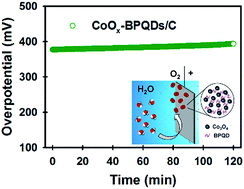Microwave-assisted synthesis of black phosphorus quantum dots: efficient electrocatalyst for oxygen evolution reaction†
Abstract
A simple and efficient approach to produce high quality black phosphorus quantum dots (BPQDs) in a common organic solvent using a microwave technique is developed in this work. This novel approach produces a stable dispersion of crystalline BPQDs with an average lateral size of 2.95 nm and thickness of 3.59 nm. We demonstrated that the as-prepared BPQDs can be an efficient electrocatalyst for the oxygen evolution reaction (OER). Our BPQDs without any supporting catalyst exhibited an impressive electrocatalytic activity for OER with an overpotential of 450 mV at 10 mA cm−2, whilst the traditional CoOx electrocatalyst showed an overpotential of 480 mV. By integrating our BPQDs with CoOx, we achieved an outstanding electrocatalytic OER performance with an overpotential of 360 mV at 10 mA cm−2, a low Tafel slope of 58.5 mV dec−1 and excellent stability, which was even comparable to the commercial IrO2 and RuO2 systems. This work introduces a promising protocol to prepare scalable BPQDs for real-world applications including electrocatalysis.

- This article is part of the themed collection: Research presented at the International Conference on Emerging Advanced Nanomaterials (ICEAN) 2018


 Please wait while we load your content...
Please wait while we load your content...